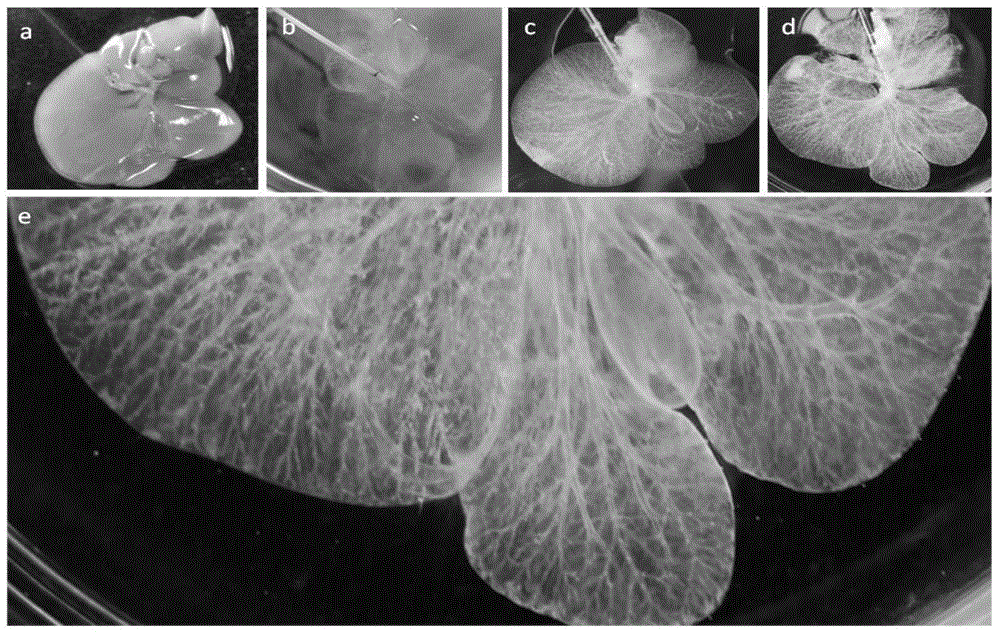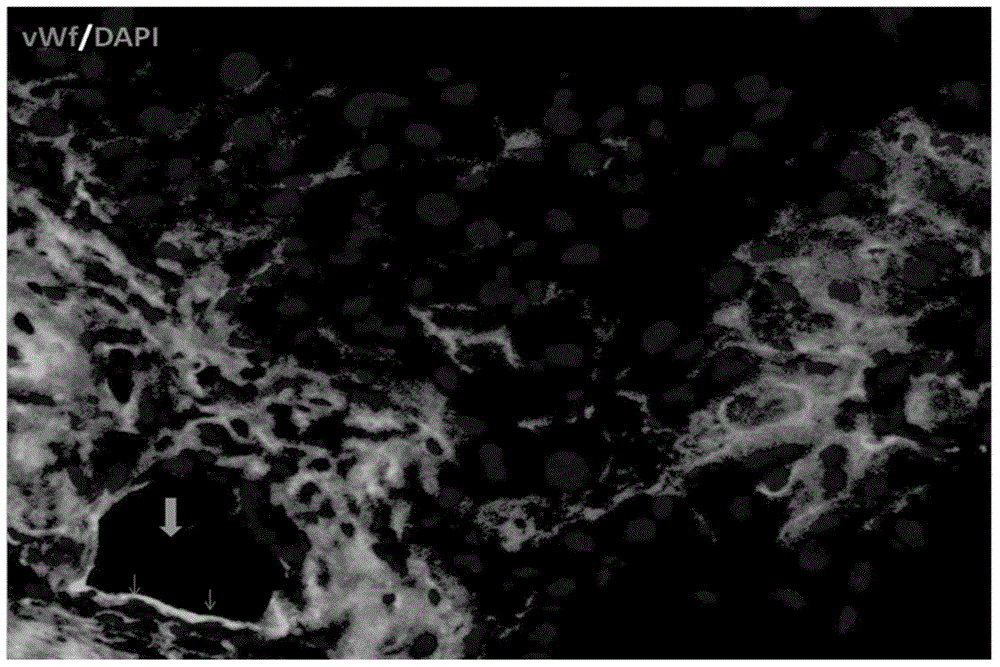Application and method of stem cell population of hepatogenous expression NG2 (neuron-glial antigen 2) as seed cells in in-vitro 3D (three-dimensional) culture and reconstruction of artificial liver
A technology of seed cells and stem cells, applied in the field of biomedicine, can solve the problems of inability to realize liver function, replacement, lack of seed cells, etc., and achieve the effect of saving one week, low cost and simple operation
- Summary
- Abstract
- Description
- Claims
- Application Information
AI Technical Summary
Problems solved by technology
Method used
Image
Examples
Embodiment 1
[0046] Example 1. Obtaining of Natural Whole Liver Decellularized Biological Scaffold (WDLS) of Adult Mouse
[0047] The main materials and reagents used in this embodiment are as follows:
[0048] Perfusion pump, ultra-clean table, infusion needle, 0.9% normal saline, 1% sodium dodecyl sulfate (SDS), 0.005% trypsin, 0.002% EDTA mixture (0.25% trypsin: 0.02% EDTA = 1:1 , Hyclone, cat.no.J110831), deionized sterile double distilled water (ddH 2 O), 1×PBS phosphate buffered saline (0.01M PBS, Beijing Zhongshan Jinqiao Biotechnology Company, cat.no.ZLI-9062).
[0049] The WDLS was obtained by in vitro perfusion, and the specific steps were as follows:
[0050] (1) Take the isolated mouse liver, and then simultaneously infuse 600 mL of 0.9% normal saline into the portal vein and hepatic artery at a speed of 5 mL / min to wash out the red blood cells, and the perfusion time is about 0.5 hours;
[0051] (2) Perfuse the liver with sterile double distilled water (ddH 2 0) to begin t...
Embodiment 2
[0055] Embodiment 2, separate culture seed cell (NG2 + HSC)
[0056] At present, there is no ideal seed cell that can reconstruct the liver organ with structure and function. Although the academic community uses adult hepatocytes and the most promising mesenchymal stem cells (Mesenchymal stem cells, MSCs), the long-term culture of hepatocytes in vitro has been proved to be poor survival and MSCs lack the potential to differentiate into functional hepatocytes in large quantities, making these Cell applications are limited. The present invention chooses NG2 + HSC is used as a seed cell, and the separation method is described in Chinese Patent Publication No. 102899291A. The research found that the NG2 + Under the induction of conditioned medium, HSC can not only rapidly (about 1 h) differentiate into a large number of functional hepatocytes ( image 3 ), which can also differentiate into endothelial cells ( figure 2 ) and liver supporting cells such as astrocytes. The re...
Embodiment 3
[0057] Embodiment 3, conditioned medium (culture microenvironment) induces NG2 + HSCs generate an artificial liver with organ architecture and functionality
[0058] The kit materials used in this embodiment are as follows: 24-well culture plate (Therom, cat.no.142475), shaker (40~240rmp / min), 37 ℃, 5% CO 2 Incubator, conditioned medium (CM1, CM2, CM3), 100 U / mL penicillin, 100 μg / mL streptomycin (Cellgro, cat.no.30-001-CI), 5000 U / mL penicillin, 5000 μg / mL streptomycin , DMEM / F12 (Gibco-BRL, cat.no.11330), ECGS (Endothelial cell growth supplements) (Pepnotech, cat.no.100-20C), HGF (R&D, cat.no.294-HG-005 / CF ), bFGF (Pepnotech, cat.no.100-188), bovine insulin (Sigma, cat.no.I6634), human transferrin (Sigma, cat.no.T1147), levothyroxine (Sigma, cat.no .T6397), sodium selenite (Sigma, cat.no.S9133), putrescine (Sigma, cat.no.P5780), progesterone (Sigma, cat.no.7556), Oncostatin M, dexamethasone, non Essential Amino Acid, L-Glutamine.
[0059] Establish a "culture microenviro...
PUM
 Login to View More
Login to View More Abstract
Description
Claims
Application Information
 Login to View More
Login to View More - R&D
- Intellectual Property
- Life Sciences
- Materials
- Tech Scout
- Unparalleled Data Quality
- Higher Quality Content
- 60% Fewer Hallucinations
Browse by: Latest US Patents, China's latest patents, Technical Efficacy Thesaurus, Application Domain, Technology Topic, Popular Technical Reports.
© 2025 PatSnap. All rights reserved.Legal|Privacy policy|Modern Slavery Act Transparency Statement|Sitemap|About US| Contact US: help@patsnap.com



